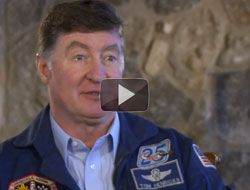Noted Astronaut Addresses Importance of Teamwork at Prostate Congress
In a similar fashion as astronauts, physicians can mitigate risks and improve outcomes with advanced planning and teamwork, four-time space shuttle commander Tom Henricks said during his keynote address at the Interdisciplinary Prostate Cancer Congress.
Tom Henricks
In a similar fashion as astronauts, physicians can mitigate risks and improve outcomes with advanced planning and teamwork, four-time space shuttle commander Tom Henricks said during his keynote address at the Interdisciplinary Prostate Cancer Congress (IPCC).
Henricks was introduced by Daniel Petrylak, MD, IPCC co-chair, who noted that while the choice of a former astronaut for a conference on prostate cancer may seem unlikely, solving the problem of prostate cancer is a huge problem. The solution could require thinking outside the box and seeking strategies from non-medical specialists.
Doctors and researchers are on a mission, similar to Henricks’, to “advance the quality of management in treating this disease and improve outcomes, and incorporate evidence-based findings and emerging technologies to provide optimal care. It’s essential that all members of the team stay up to date on data,” Petrylak said.
The NASA shuttle program encompassed all aspects of large team management, Henricks said; although, the most visible portion was often just the handful of astronauts who went up into space, behind them were about 30,000 NASA workers and contractors. While many of these workers had no contact at all with the people actually flying the shuttle, their actions were still of vital importance.
Showing a clip of a shuttle blastoff filmed from the pilot’s seat, Henricks noted amid the sound of roaring engines and intense vibration that “launch is the most dynamic phase, and you have a 1 in 75 chance of losing crew and spacecraft.” In mission-critical situations, like in the clinic or operating room, good leadership makes all the difference, he said.
Leadership starts way before liftoff or scrubbing in for an operation, said the former astronaut and current consultant on aviation analysis and planning. Systems, processes, and procedures need to be carefully designed and managed, Henricks said.
“Leaders are the greatest influence on culture, and everyone can be a leader. You don’t have to be the oncologist in the room,” said Henricks, whose family has not been spared the scourge of cancer. His mother is a survivor of breast cancer and he lost an uncle to cancer within the past 12 months. His father has melanoma.
Signs of good leadership include good communication, metrics, reward and recognition, focus and discipline, team selection, and providing the tools for development, he said.
It’s not always the case that members of a team can learn to appreciate the importance of shared objectives and cooperation, he said. “You still have to manage the 20% that don’t get it, and sometimes you have to manage them out.”
Henricks Applies NASA Concepts to Medicine at Prostate Congress
To illustrate some of the problems that occur during group projects, Henricks analyzed the two shuttle disasters involving the Challenger in 1986 and the Columbia in 2003. The Challenger was destroyed on launch by failure of an O-ring seal and the Columbia disintegrated on reentry as a result of damage that occurred on launch.
In both cases, lack of trust among team members was at the root of the mishaps, Henricks said. Complex communications, a “beat up staff”, “paralyzed middle management,” a lack of metrics and performance incentives, and a failure to relentlessly focus on critical issues such as safety contributed to the disasters.
For example, in the case of the Columbia, “the voices that said there may be a hole under the wing and we can get to it with military satellites never got to the decision makers,” Henricks said. It was the damage to the underside of the craft that enabled hot gases on reentry to undermine the integrity of the vehicle and cause it to break apart.
Henricks also defined elements of good leadership, among which was taking the long, “200 mile view” that takes one’s gaze beyond the confines of one’s own specialty and beyond the barriers that obscure solutions. “Sometimes the solution may be outside your current skill set,” he said.
Team spirit and looking after co-workers also count. “Ask your teammates what’s keeping you awake at night. I strongly encourage that,” Henricks said.
Henricks’ mission responsibilities, besides taking crews into space, have included coordinating elements of the shuttle program under a $500 million budget. Over the course of his NASA career, which began in 1985, Henricks was awarded several special honors and accrued extensive flight experience. He is noted as being the first individual to log over 1000 hours as a Space Shuttle pilot/commander. In more recent years, Henricks engineered a switch to digital publishing for Aviation Week magazine, which the American space hero acknowledged was a challenge even for his prodigious management skills.
<<<
View more from the 2015 Interdisciplinary Prostate Cancer Congress




